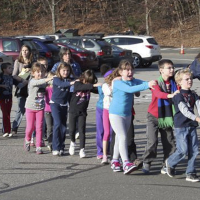Almost 1 in 3 Victims of Mass Killings are Younger than 18
 Sandy Hook Elementary School December 14, 2012 ( (photo: Shannon Hicks, Newtown Bee, AP)
Sandy Hook Elementary School December 14, 2012 ( (photo: Shannon Hicks, Newtown Bee, AP)
If the late Nelson Mandela was correct in his belief that “there can be no keener revelation of a society’s soul than the way in which it treats its children,” then the soul of the United States is damaged. Not only does the U.S. permit 21.8% of its children (16.1 million kids) to grow up in poverty, but nearly one of every three mass killing victims are children, despite gun and public safety laws, according to a USA Today analysis of mass killings since 2006.
In the course of performing their investigation, the journalists found that the FBI data on mass killings, known as the Supplemental Homicide Report, was filled with errors and omissions, mostly arising from mistakes made by local police who submit reports to the FBI. As a result, the database was found to have an accuracy rate of only 61%. Several well-publicized mass killings were absent, while several cases were found to be erroneously included. As corrected, the database shows that the number of mass killings has not increased recently; most occur among family members; and that killers typically use handguns rather than assault weapons.
Investigators also determined that 363 children died in mass killings—defined as those involving at least four victims in a single incident—comprising nearly one-third of all victims. Their average age was 8 years old and about three-quarters of them were killed by someone they knew: more than a third by a blood parent and about four in ten by stepparents, parents’ lovers or other family members.
Child survivors of such mass attacks have an especially hard time because their trauma is worsened by the pre-existing close relationship with the attacker, who is usually suffering from a psychotic break involving revenge fantasies, according to Susan Hatters Friedman, a forensic psychiatrist who studies child homicide.
“For a lot of kids, the feeling that the world is no longer safe is not an uncommon experience. Post-traumatic symptoms strengthen that perception,” said Steven Marans, a child trauma expert at Yale University, who stressed that a child experiences an overwhelming loss of control when faced with an attack such as a mass killing.
Because children often withdraw when faced with trauma, the also-traumatized adults around them may misinterpret their silence as a lack of grief and fail to intervene therapeutically. In addition, adequate help is not widely available in all parts of the country. “From a national perspective, considering the scope of the problem, this is not enough,” said John Fairbank, co-director of the UCLA-Duke University National Center for Child Traumatic Stress told USA Today. “Many children who experience such events are not able to access care, and as a nation, we need to do more.”
-Matt Bewig
To Learn More:
In Mass Killings, Smallest Victims Bear Biggest Burden (by Meghan Hoyer, USA Today)
USA TODAY Research Reveals Flaws in Mass-Killing Data (by Paul Overberg, Jodi Upton, and Meghan Hoyer, USA Today)
Three-Quarters of Weapons Used in Mass Killings in U.S. were Bought Legally (by Noel Brinkerhoff, AllGov)
Murder Rate Down, but Random Mass Shootings Up (by Matt Bewig, AllGov)
- Top Stories
- Unusual News
- Where is the Money Going?
- Controversies
- U.S. and the World
- Appointments and Resignations
- Latest News
- Trump to Stop Deportations If…
- Trump Denounces World Series
- What If China Invaded the United States?
- Donald Trump Has a Mental Health Problem and It Has a Name
- Trump Goes on Renaming Frenzy






Comments